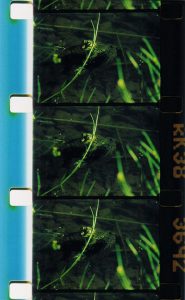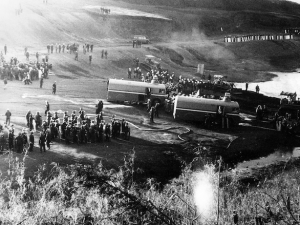Changing the story: Film and environmental histories
by Teresa Castro
“Film is history, many histories”, observed artist and filmmaker Lis Rhodes. As I write this text, her words run through my mind like a mantra. Film is history in as much as every image is a historical object. But perhaps most of all, film is many different histories. Think of ecology and the environment. When it comes to their complex entanglements with film, there is still a wealth of stories to be told. Cinema has both wittingly and unwittingly documented the relentless unfolding of our planetary emergency, playing an active role in projects of mastery and control over nature, but also raising awareness and building attentiveness toward the environment and the more-than-human. Significantly, it is a tornado that transports Dorothy to a place over the rainbow in The Wizard of Oz (1939) – a so-called “natural disaster” not unknown to Kansas and the Great Plains, but in the 1930s all the more devastating because of land erosion brought about by over-farming and cash-crop agriculture. Pare Lorentz famously makes that point in The Plow that Broke the Plains (1936), a New Deal-funded documentary hinting, in its prologue, at a link between settlement (the removals of Indigenous people and bison from the Plains) and the disappearance of the grasslands. For thousands of years, the latter held together a fragile and rich layer of sediment. In other words, even when cinema sweeps its spectators into a fantasy world, the environmental reality is never far away.
Histories are anchored in their present. In our age of environmental collapse, we need histories of specific films, of the dreams they tell and the fears they convey. But we also need histories that go beyond representation and the ecological imaginary alone. Histories that are aware of raw materials, natural resources, voracious energy economies. Histories not oblivious to that which sits in the shadow of relentless ideologies of growth and progress (like the devastation brought about by the Dust Bowl). Histories attentive to neglected human and more-than-human actors. Histories of bodies, some of them contaminated. Histories of affects and sensibilities. Histories of multiple cosmologies – as film demonstrates well, modernity’s vision of the world and its project of technological mastery over nature was never unequivocal. Histories that understand the urge to explore different perspectives and the need to change “the story”. The latter concerns as much our anthropocentric view of cinema as well as our wider understanding of what “progress”, “development” or “humanism” might mean today.

Why history?
In recent years, awareness of the climate crisis has spurred a number of studies on the environmental footprint of film. According to a 2006 report, Hollywood and its studios are major polluters in California, second only to the oil industry. In France, the Ecoprod collective (a leading initiative for sustainable film production) estimated in 2021 that the French cinema and audiovisual sector releases 1.7 million tons of CO2 into the atmosphere every year, generating a growing amount of waste and pollution (the North American film and audiovisual industry is estimated to release 15 million tons of CO2 into the atmosphere every year). The digital transition has not put us on the right track – relying on rare earth metals whose mining is often made at the expense of the health and well-being of local populations, digital technology consumes increasing amounts of energy and water. Achieving sustainability in film is a real challenge – not the least because the very notion of “sustainability” is problematic, in particular when disconnected from a critical reflection on the project of growth-maximising economies.
Despite such debates, the extractive, energy-consuming and potentially toxic dimension of photo-filmic industries is rarely evoked from a historical perspective. The issue is far from new – film is, and has always been, environmental. Not only because its images have helped to shape relationships and attitudes towards the environment and the more-than-human, but first and foremost because cinema is material. Behind film and photography’s much-pondered mechanical reproduction lies the saga of an industrial and chemical modernity powered by fossil fuels and natural resources; a modernity immediately haunted by the nuisances, pollutions and hazardous waste arising from the extraction and production processes it put forth. To neglect this side of the story is to depoliticise the long history of environmental degradation and to ignore what Nadia Bozak describes in The Cinematic Footprint as “the intimate and heretofore overlooked relations between the consumption of natural resources and film’s ontological, aesthetic, and political dimension.”
Indeed, conventional film histories tend to turn a blind eye to cinema’s critical relationship to “fossil capital” – an economic model based on the exploitation of coal, crude oil and natural gas and, more broadly, on a conception of nature and human labour in terms of interchangeable units or “resources”. We think little, for example, about film’s raw materials, the workers, exchanges and networks behind them. However, knowing that for a considerable amount of time there was no film stock without nitric acid made from Chile saltpetre (a compound used to massively produce fertilizers and explosives at the beginning of the 20th century) or natural camphor extracted by the Japanese from almost-exhausted Taiwan forests allows us to resituate film, and in particular nitrate celluloid, as a chemical industry deeply tangled in empire. Likewise, remembering that all of our current photochemical supports are still petroleum-based reminds us that greening our production modes is not as straightforward as we might think – which does not mean that some contemporary photochemical practices, as evinced by a particularly lively experimental subculture, do not contribute to raising awareness and consolidating an environmental consciousness, as film theorist Kim Knowles points out.
History can help us broaden our understanding of cinema, disclosing unsuspected parallels and entanglements, like those between celluloid film, industrial dyes and artificial flowers. A flexible and highly-flammable material whose main source in the United States was cotton mill waste from spinning plants, celluloid was used from the 1870s onwards as a substitute for ivory and tortoiseshell. In addition to becoming the film industry’s stock of choice at the end of the 19th century, celluloid previously transformed the buoyant industry of artificial flowers, imposing itself as a cheaper alternative to organic funeral wreaths. Jean-Luc Godard seemed to recall this curious fact when he observed in Histoire(s) du cinéma (1988-1998) that Technicolor films used the same dominants as funeral wreaths. But Technicolor is not just celluloid – it is celluloid in colour. The synthetic dyes used in colour film stocks and celluloid wreaths are the child of well-known chemical industries – some of which, like Agfa and Bayer, added the fabrication of photographic chemicals and papers to their primary production of anilines and pharmaceutic drugs. Chemists invented colours, including those used in film, from coal-tar and other waste materials. Industrial waste and pollution turned into value and generated more commodities.
Such elements are far from anecdotal. Environmental histories are as much an empirical as a theoretical endeavour; retooling film theory in order to make it more environmentally conscious is also part of the challenge. For example, and as suggested by Bozak, film’s environmental impact invites us to reframe the old question of ontology. Shaken by endless debates over the more or less radical rupture of the digital, “indexicality” – understood here as the photochemical image’s privileged relationship to the real, as theorised by André Bazin, Siegfried Kracauer and others – becomes the hinge around which to think about the extractive nature of cinema. If Bazin et alia sacrificed film’s mineral and chemical origins on the altar of ontology, we can do otherwise. We know that, like the bodies of insects preserved intact in amber, “change mummified”, as Bazin described film, is equally enrobed in matter. Composed of all sorts of petrochemical ingredients, as well as animal collagen, film stock shares with amber (a fossilised tree resin) its fossil origins. It depends on minerals and fossil fuels, just as memory cards and data centres still do. The energy transition to low-carbon systems and fossil-free economies powered by lithium-ion batteries does not make the digital immaterial – on the contrary. The changes brought about by artificial intelligence rely on massive amounts of water and electricity. To return to ontology, it is not the “real” that leaves its imprint on film or is stored as a binary code on a chip. Film and the memory card are literally “the real”: the reality of the resources, exchanges and processes behind their manufacture and circulation. Moreover, and as Eastman Kodak’s well-known example recalls (Kodak’s environmental impact on its historical Rochester plant are well documented, the lower Genesee River being contaminated by decades of discharges), film can also leave a toxic and literal imprint on various bodies. Film is indeed history, many histories.

Other stories
Like other histories aiming at difference, environmental film histories are versed in the craft of attending to. They try to repair silences and holes in the fabric of conventional accounts, weaving together different voices, shifting perspectives and combining multiple scales. As environmental historian William Cronon wrote 30 years ago in “A Place for Stories: Nature, History and Narrative” (1992), environmental (film) histories are about “many stories, of many places, in many voices, pointing toward many ends.” In The Plow That Broke the Plains, for example, the choice to evoke the Dust Bowl as a man-made disaster is worth noting. If the film remains fixed on humans, it nonetheless invites its spectator to rethink what a “natural disaster” is. Natural hazards like tornadoes become “disasters” when they meet human populations. And like the example of the Dust Bowl perfectly illustrates, such calamities are often exacerbated by human actions.
Spawned by modernity, cinema was from its beginnings haunted by the twin drives of destruction and preservation. A scene from Jacques Cousteau and Louis Malle’s documentary The World of Silence (1956), one of the first films to use underwater cinematography in colour, encapsulates this well. In it, two Calypso crew members use dynamite to collect fish specimens from a coral reef. The voiceover explains that using explosives for commercial fishing is illegal, but that the technique can be employed for scientific purposes, since it allows marine biologists to make a complete inventory of the species inhabiting a specific place. That is, one kills in order to document and to preserve – among other things, on celluloid – that which is bound to disappear. Oceanographer Cousteau would later become involved in marine conservation, his name being given to a coral reserve in the Guadeloupe Islands. The sequence not only attests to an important transformation of sensibilities (what shocks us today did not necessarily shock spectators 75 years ago), but also to the violent lineage of visual representation behind many “nature films”, among which are hunting and expedition films. Environmental film histories explore such paradoxical configurations.
Having said this, environmental film histories can also help us to exonerate cinema (or at least some of its ambivalent images) from the essentialist and often punitive discourses that inevitably ascribe it to different domination and objectification projects. Film can also raise awareness. On a very concrete level, it does so when it documents, and sometimes actively participates in, social and political struggles like those filmed over the years by Japanese documentary filmmakers Ogawa Shinsuke and Tsuchimoto Noriaki. In the late 1960s, Ogawa and the filmmaking collective Ogawa Pro moved to Sanrizuka, near Tokyo, directing a series of seven films chronicling the uprising against the construction of Narita Airport. Building the airport meant expropriating agrarian land from local peasants and resettling their communities. The project was vehemently contested by numerous farmers, their struggle drawing support from radical students and different movements across Japan. In The Battle Front for the Liberation of Japan – Summer in Sanrizuka (Ogawa Shinsuke, 1968), the camera is placed in the middle of the rallies and violent clashes with the police; in Sanrizuka – Heta Village (Shinsuke Ogawa, 1973) attention is poignantly given to that which is worth fighting for: village life itself, with its customs, tempos and rhythms. After the waning of the Sanrizuka protests, Ogawa and his companions moved to Yamagata Prefecture, in Northern Japan, where they lived communally, making a set of films on farming and village life.
As for Tsuchimoto, he devoted a considerable part of his career to the tragic consequences of mercury poisoning in the Minamata area. From 1932 to 1968, a chemical plant owned by the Chisso Corporation discharged tons of methylmercury in the Minamata Bay, causing a neurological disease affecting humans and animals known as Minamata disease. Tsuchimoto, who first visited Minamata in 1965 in order to shoot a television documentary, dedicated 17 films and videos to the victims of this massive environmental disaster, among which are Minamata: The Victims and Their World (1971) and The Shiranui Sea (1975). Made with the patients and their families, his films are a powerful reflection on the responsibility and ethics of documentary filmmaking. Like Ogawa, Tsuchimoto did not make films on a subject, but with his subjects. Environmental film histories take an interest in such forms of continued engagement.
In addition to such films – and to many other amateur and collective productions documenting environmental activism, from the 1980s Plogoff and Greenham Common anti-nuclear protests to the more recent Dakota Access Pipeline protests and Sainte-Soline protests – cinema can also help us to broaden our attentiveness and sensibility toward the environment and the more-than-human. Attention is a perceptual politics, determining what is worth noticing and therefore what is worth caring about – as filmmakers Jean-Marie Straub and Danièle Huillet knew so well. In this sense, film is an extraordinary means to reckon with the politicisation of the living to which ecological thought has been inviting us for several decades. How has cinema helped us to foreground those who are usually relegated to the background? How has it discarded (and helped us to discard) dualistic understandings of “humanity” and “nature”? How has it depicted sympathetic partnerships, among humans and with the more-than-human? Exploring less anthropocentric narratives such as those suggested by these questions is also one of the challenges of environmental film histories. This decentring does not mean abdicating from “the human” (a concept tainted by its historical exclusion of many humans, as well as its persistent tendency to define itself in opposition to an inferior Other, as pointed out by the anti-speciesism movement), but moving forward to what philosopher and ecofeminist Val Plumwood described as a different mode of humanity. A humanity not located outside “nature”, but part of it; a humanity endorsing more caring, communicative and attentive attitudes towards the earth, other humans and our more-than-human counterparts.
From its beginnings, film was pictured as a human-centred medium, consistently measuring its shots to human bodies and human time scales. But filmic technology was quick to unmoor itself from its anthropocentric underpinnings, exploring other-than-human scales and helping to shake the boundaries of century-old conceptions about life and the living. The example of historical time-lapse films on plant motion is particularly interesting – as I have argued elsewhere, they often invited their spectators to regard plants as kin, their animistic images introducing fissures in the normative narrative around human and non-human identities. Writing about The Life of a Plant (Percy Smith, 1926), a Secrets of Nature production starring a garden nasturtium, a reviewer commented that after seeing the film “you find it difficult to believe (…) that the life of a plant is not as sentient as your own.” Indeed, “the butterfly wing-dust of wonder” that ecofeminist philosopher Val Plumwood believed modernity had stolen from us is often present in film. The latter can help us to recast knowledge as a relationship of awe (and to conceive of animals, plants and the living in intentional terms).
Environmental film histories are not always about extraction, contamination and death. They are also histories of companionship and collaborative survival. They are interested in the affective ecologies involving humans, more-than-humans and filmic technology. They take seriously the idea of the camera as a technical companion. They are drawn to relational modes of perception. Moreover, they are also histories of a sensibility toward life and the living. They document attention, understood as a caring faculty, an ethics of looking and listening exemplified, for example, by Italian filmmaker Michelangelo Frammartino’s Le Quattro Volte (2010), a film whose protagonists are an old herdsman, a young goat and a fir tree. Put differently, history writing – a generic formula, encompassing the contributions of scholars, film programmers, critics, archivists and artists – can also be a way of caring, calling attention to, becoming aware of. By doing this, it fully becomes a practice in and of our present moment.
Teresa Castro is Associate Professor in Film Studies at Université Sorbonne Nouvelle and currently a Research Fellow at Centre National de Recherche Scientifique, Centre Alexandre Koyré. A significant part of her recent writing has focused on the links between film and animism, plants in visual culture and the environmental histories of cinema and photography.
